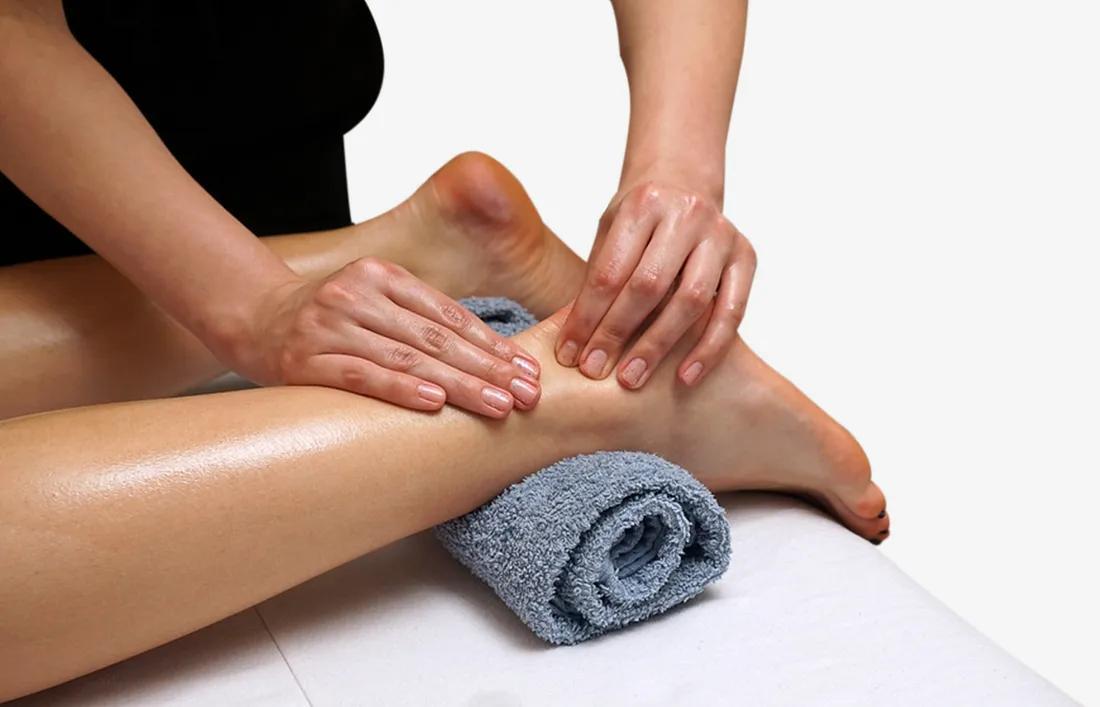Scan for
Download the App
Scan for
Download the App


Daily routine work and lifestyle can sometimes overexert your muscles, causing leg pain. To relieve this condition, it is important to perform specific exercises. However, there are various leg massage techniques and unusual ways that can also be used to alleviate leg pain. In this article, we will explore these techniques, their benefits, and some helpful tips to make the most out of your leg massages.
Leg pain can be caused by various factors. The primary cause is overexertion, which can occur due to activities such as excessive brisk walking, sports, or accidents. Common symptoms of leg pain include cramps, numbness, weakness, throbbing, or a burning sensation. In addition to overexertion, conditions such as Thrombosis and Sciatica can also contribute to leg pain.

Thrombosis is characterized by blood clots that restrict blood circulation. These clots are often the result of vein injuries, prolonged immobility after surgery, or long journeys. On the other hand, Sciatica refers to the dull ache caused by the compression or irritation of the Sciatic nerve, which runs from the lower back through the thighs and buttocks. Leg pain can also be associated with diabetes.
Leg massage techniques involve applying selective pressure to specific points on the feet. Performing leg massages at home can offer several benefits. Let’s explore some of the key benefits associated with leg massage techniques:
1. Reduces Stress and Anxiety Conditions
Studies have shown that leg massage techniques can effectively relieve stress and anxiety. By stimulating the central nervous system, these techniques help the body release tension and promote relaxation. Leg massages can also help alleviate headaches and migraines, providing relief for both the body and mind.
2. Helps Improve Circulation
The lymphatic system plays a crucial role in the body’s immune system and the removal of waste fluids. Leg massages can facilitate manual lymph drainage, aiding the movement of lymph and reducing swelling in the legs and ankles.
3. Relieves Pain
Sore legs are a common symptom of leg pain. Intense muscle massages targeting the ankle and knee joints can help alleviate pain by increasing blood flow and reducing inflammation. Leg massages also promote the release of endorphins, which are natural painkillers produced by the body.
Before diving into the main leg massage techniques, it is essential to prepare your feet for the upcoming exercises. Warmup twists serve as an excellent starting point to enhance blood flow and loosen up the foot muscles.

To perform warmup twists, follow these steps:
By engaging in warmup twists, you activate the muscles and increase their flexibility, ensuring a more effective leg massage session.
The arch rub technique focuses on massaging the underside of the foot, specifically targeting the arch area. This technique helps alleviate tension and discomfort, promoting relaxation and improved blood circulation.

To perform the arch rub technique, follow these steps:
By gently massaging the arch of your foot, you release built-up tension and create a soothing sensation.
Toe bends are an effective method to enhance flexibility in the toes and the entire foot. By regularly practicing this technique, you can improve the range of motion in your toes and prevent stiffness.

To perform the toe bend technique, follow these steps:
Through toe bends, you encourage flexibility and mobility in the toes, which can alleviate discomfort caused by tight footwear or prolonged standing.
As the name suggests, the foot spread technique involves gently spreading the foot to its natural width. This technique helps relieve tension in the foot muscles and promotes a sense of relaxation.

To perform the foot spread technique, follow these steps:
By performing the foot spread technique, you encourage proper alignment and release tension in the foot muscles, contributing to overall comfort.
The heel squeeze technique primarily targets the backside of the feet, relieving any stresses or tightness in that area. By focusing on the heel, you can alleviate discomfort and promote relaxation.

To perform the heel squeeze technique, follow these steps:
By engaging in the heel squeeze technique, you stimulate blood flow and loosen the muscles in the backside of the feet, leading to enhanced comfort.
The knuckle technique is another effective way to massage the bottom of the foot, targeting specific pressure points and promoting relaxation.

To perform the knuckle technique, follow these steps:
By using the knuckles, you can target specific areas of tension and release the muscles, providing a deep and satisfying massage experience.
The thumb technique involves using your thumb to apply pressure to the backside of the foot, focusing on specific areas and promoting relaxation.

To perform the thumb technique, follow these steps:
By utilizing your thumbs, you can effectively target pressure points and provide a satisfying massage experience.
Pressure points are specific areas on the foot that, when stimulated, can help alleviate leg pain and discomfort. By applying pressure to these points, you can experience relief and relaxation.

To perform the pressure points technique, follow these steps:
By focusing on pressure points, you can target specific areas of tension and promote pain relief and relaxation.
The Achilles massage technique is particularly beneficial for easing pressure on the Achilles tendon, a common source of leg pain and discomfort.

To perform the Achilles massage technique, follow these steps:
By massaging the Achilles tendon, you can relieve tension and promote a sense of relief in the lower leg area.
The top and side circles technique involves pressing circular movements on the foot, targeting various areas and promoting relaxation.

To perform the top and side circles technique, follow these steps:
By engaging in the top and side circles technique, you can stimulate blood flow and provide a comprehensive massage to the entire foot.
The toe massage technique is specifically designed to relieve tension and cramps in the toes. By massaging the toes, you can promote relaxation and enhance overall foot comfort.

To perform the toe massage technique, follow these steps:
By massaging the toes, you release tension and promote flexibility, leading to enhanced foot comfort.
The finishing strokes technique serves as a perfect conclusion to your leg massage session. This technique allows for a gentle and soothing end to your massage, promoting relaxation and a sense of calm.

To perform the finishing strokes technique, follow these steps:
By engaging in the finishing strokes technique, you can bring your leg massage to a peaceful end, leaving you feeling relaxed and rejuvenated.
While the techniques mentioned above provide effective leg massage methods, there are also some unconventional ideas you can explore for self-leg massage:
These unusual ideas can complement traditional leg massage techniques and offer alternative ways to provide relief and relaxation to your legs.

To ensure an effective and safe leg massage, consider the following tips:
If you prefer a hands-free approach or want to enhance your leg massage experience, you may consider using foot and calf massage machines. These machines are designed to provide targeted massage to the feet and calves, offering various massage techniques and intensity levels.

Two popular types of foot and calf massage machines are:
When using foot and calf massage machines, it is essential to follow the manufacturer’s instructions and choose the settings that suit your needs and preferences. These machines can be a convenient alternative or complement to traditional leg massage techniques.
While leg massage can be beneficial for most individuals, there are situations where leg massage should be avoided or modified. It is important to consult with a healthcare professional if you have any specific medical conditions or concerns. Some situations where leg massage may not be suitable include:
Always prioritize your safety and well-being, and consult a healthcare professional if you have any concerns or medical conditions.
A1: Leg massage offers numerous benefits, including improved circulation, reduced muscle tension, relaxation, relief from leg pain and soreness, enhanced flexibility, and a sense of overall well-being.
A2: It is recommended to incorporate leg massage into your self-care routine at least once or twice a week. However, you can adjust the frequency based on your individual needs and preferences.
A3: While massage oil is specifically designed for massage therapy and provides better lubrication, you can use regular lotion as an alternative. Just ensure it’s a non-greasy lotion that allows your hands to glide smoothly on the skin.
A4: Yes, you can massage your legs if you have varicose veins. However, it is important to apply gentle pressure and avoid excessive force directly on the affected areas. Consult with a healthcare professional for specific guidance.
A5: Leg massage should be avoided or modified in the following situations: open wounds or skin infections, deep vein thrombosis (DVT), pregnancy (without consulting a healthcare professional), severe leg pain or recent leg injury. Always consult a healthcare professional if you have any concerns or medical conditions.
A6: It is generally safe to use foot and calf massage machines every day. However, it is important to follow the manufacturer’s instructions and listen to your body. If you experience any discomfort or pain, reduce the frequency or intensity of use.
A7: A leg massage session can vary in length, but ideally, it should last for at least 15–20 minutes to allow sufficient time to address different areas and promote relaxation. You can extend the duration based on your preferences and available time.
A8: Leg massage can provide temporary relief and relaxation for individuals with restless legs syndrome. However, it is essential to consult with a healthcare professional for a comprehensive treatment plan for managing RLS.
A9: Leg massage can be performed on yourself, known as self-massage. You can use your hands or explore tools such as massage balls or foot rollers. Having a partner or professional masseuse can provide additional benefits, but self-massage is an effective option for self-care.
A10: Yes, leg massage can aid in sports recovery by reducing muscle soreness, promoting circulation, and relieving tension. It can be a valuable part of a post-workout routine to help enhance recovery and prevent injuries.
Remember, if you have any specific medical concerns or conditions, it is always advisable to consult with a healthcare professional for personalized advice before engaging in leg massage or any form of self-care.
Disclaimer: This article is for informational purposes only and is not intended to replace professional medical advice. If you have any medical concerns or conditions, please consult with a healthcare professional.